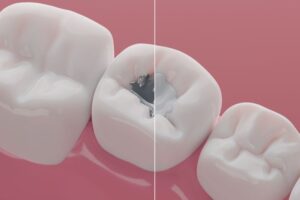
For many years, dentists relied solely on silver amalgam fillings (also called metal fillings) to treat cavities. Certainly, these fillings are strong, and they served their purpose. However, dentistry has evolved, and more and more people — both dentists and their patients — are gravitating toward other options. Why should you consider replacing your old metal fillings with a more modern alternative? As this blog post explains, your health could be at stake.
Amalgam Fillings and Blood Mercury Levels
Silver amalgam fillings are made of roughly 50% mercury. For a long time, it was widely thought that this was not a problem; the relatively minor mercury exposure seemed not to be a threat.
However, recent research on the subject is worth considering. A study published in 2016 looked at data from nearly 15,000 individuals. It was found that those with more than eight fillings had 150% more mercury in their blood than individuals with no fillings! This can happen because even in its solid state, mercury can release vapors that get inhaled.
While some individuals do not notice any obvious symptoms because of their fillings, others are more sensitive. They may experience issues like memory problems, tremors, headaches, mood changes, and gut inflammation.
Tooth-Colored Fillings: A Biocompatible Alternative
If you are concerned about the presence of mercury in your old fillings, talk to your dentist about your options. They may recommend that you swap out those old restorations for tooth-colored fillings. These are made of a biocompatible composite resin, which is completely metal-free. Therefore, they carry absolutely zero risk of mercury poisoning.
They also offer some other outstanding advantages:
- They look beautiful. Whereas metal fillings are dark and unattractive, tooth-colored fillings match the color of the surrounding enamel. They blend in beautifully!
- They cause less sensitivity. Tooth-colored fillings do not conduct temperatures like metal, so your teeth may be less sensitive after you get them.
- Lower risk of leakage. Metal fillings simply sit inside cavities, whereas tooth-colored fillings actually bond with the surrounding dentition. This reduces the risk of leakage.
- Simpler process. Placing a tooth-colored filling requires less tooth preparation than placing a metal one.
Metal fillings are quickly becoming obsolete! Talk to your dentist if you are interested in updating your smile.
Meet the Practice
Dr. Helen Harless is a highly accomplished dentist in Boise, ID. She and our team care greatly about the overall health of our patients, so we offer biocompatible tooth-colored fillings. If you would like to replace your old metal fillings, we would be happy to help you understand the road ahead. Contact Southwest Dental Arts at 208-322-5655.
